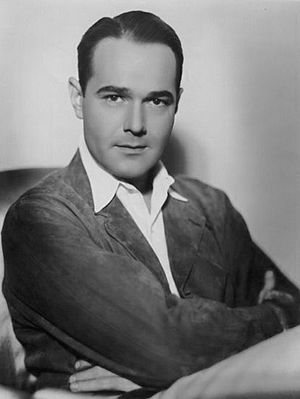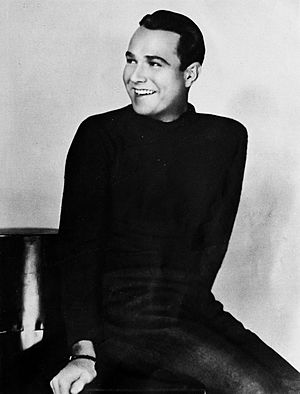William Haines facts for kids
Quick facts for kids
William Haines
|
|
|---|---|

Haines in 1920
|
|
| Born |
Charles William Haines
January 2, 1900 Staunton, Virginia, U.S.
|
| Died | December 26, 1973 (aged 73) Santa Monica, California, U.S.
|
| Resting place | Woodlawn Memorial Cemetery, Santa Monica |
| Occupation |
|
| Years active | 1922–1973 |
| Partner(s) | Jimmie Shields (1926–1973) |
Charles William Haines (January 2, 1900 – December 26, 1973) was an American actor and interior designer.
Haines was discovered by a talent scout and signed with Goldwyn Pictures in 1922. His career gained momentum when he received favorable reviews for his role in The Midnight Express. He was cast in the 1926 film Brown of Harvard and his performance solidified his screen persona as a wisecracking, arrogant leading man. By the end of the 1920s, Haines had appeared in a string of successful films and was a popular box-office draw.
Haines' acting career was cut short by the studios in the 1930s due to his refusal to deny his homosexuality. He quit acting in 1935 and started a successful interior design business with his life partner Jimmie Shields, and his work was widely patronized by friends in Hollywood. Haines died of lung cancer in December 1973 at the age of 73.
Early life
Haines was born on January 2, 1900 (he claimed he was born on January 1) in Staunton, Virginia, the third child of George Adam Haines, a cigar maker, and Laura Virginia Haines (née Matthews). Two older siblings died in infancy. He had four younger siblings: Lillian, born in 1902; Ann, born in 1907; George, Jr., born in 1908; and Henry, born in 1917. He was baptized at the Trinity Episcopal Church in Staunton at the age of eight, where he later sang in the choir. He became fascinated with stage performance and motion pictures at an early age, spending hours watching early silent films in local theatres.
Haines ran away from home at the age of 14, accompanied by an unidentified young man whom Haines referred to as his "boyfriend". The pair went first to Richmond and then to Hopewell, which had a reputation for immorality. They both got jobs working at the local DuPont factory, producing nitrocellulose for $50 a week. To supplement their income, they opened a dance hall. Haines' parents, frantic over his disappearance, tracked him through the police to Hopewell. Haines did not return home with them, remaining instead in Hopewell and sending money back home to help support the family. The couple remained in Hopewell until most of the town was destroyed by fire in 1915. Haines moved to New York City. Whether his boyfriend accompanied him is unclear.
Following the bankruptcy of the family business and the mental breakdown of George Sr., the family moved to Richmond in 1916. Haines moved there in 1917 to help support them. With his father recovered and employed, Haines returned to New York City in 1919, settling into the burgeoning gay community of Greenwich Village. He worked a variety of jobs and was for a time the kept man of an older woman before becoming a model. Talent scout Bijou Fernandez discovered Haines as part of the Goldwyn Pictures' "New Faces of 1922" contest, and the studio signed him to a $40-a-week contract (~$700 in 2022 terms). He traveled to Hollywood with fellow contest winner Eleanor Boardman in March of that year.
Career
Acting
Haines' career began slowly, as he appeared in extra and bit parts, mostly uncredited. His first significant role was in Three Wise Fools (1923). He attracted positive critical attention and the studio began building him up as a new star. However, he continued to play small, unimportant parts at Goldwyn. When his home studio lent him to Fox in 1923 for The Desert Outlaw, he got the opportunity to play a significant role. In 1924, MGM lent Haines to Columbia Pictures for a five-picture deal. The first of these, The Midnight Express (1924), received excellent reviews, and Columbia offered to buy his contract. The offer was refused and Haines continued in bit roles for Goldwyn. Haines scored his first big personal success with Brown of Harvard (1926) opposite Jack Pickford and Mary Brian. It was in Brown that he crystallized his screen image, a young arrogant man who is humbled by the last reel. He returned repeatedly to that formula for the next several years.
On a trip to New York in 1926, Haines met James "Jimmie" Shields. Haines convinced Shields to move to Los Angeles, promising to get him work as an extra. The pair soon began living together and viewed themselves as a committed couple, though newspapers did not mention their relationship.
Haines found box-office success with Little Annie Rooney (1925), costarring Mary Pickford, and Show People (1928), costarring Marion Davies. He was a top-five box-office star from 1928 to 1932. He made a successful transition into "talkies" in the part-talking film Alias Jimmy Valentine (1928). He was forced to take elocution lessons for the film. His first all-talking film, Navy Blues, was released the following year. He starred in Way Out West in 1930. The 1930 Quigley Poll, a survey of film exhibitors, listed Haines as the top box-office attraction in the country.
In 1933, Haines was arrested in a YMCA with a sailor he had picked up in Los Angeles' Pershing Square. Louis B. Mayer, the studio head at MGM, delivered an ultimatum to Haines: choose between a sham lavender marriage, his relationship with Shields or his relationship with the sailor. Haines chose Shields and they remained together in a private relationship for 47 years. Mayer then fired Haines and terminated his contract. He made a few minor films at Poverty Row studios and soon retired from acting. His final films were made in 1934 with Mascot Pictures, Young and Beautiful and The Marines Are Coming.
Haines continued to receive offers for film roles. During production of Sunset Boulevard (1950), he was offered a cameo role in the film, which he declined. He later said, "It's a rather pleasant feeling of being away from pictures and being part of them because all my friends are. I can see the nice side of them without seeing the ugly side of the studios."
Interior design
Haines and Shields began a successful dual career as interior designers and antique dealers. Among their early clients were friends such as Joan Crawford, Gloria Swanson, Carole Lombard, Marion Davies, and George Cukor. When Jack L. Warner remodeled his estate in 1937, he hired Haines as interior decorator.
The couple finally settled in the Hollywood community of Brentwood and their business prospered until their retirement in the early 1970s, except for a brief interruption when Haines served in World War II. In the 60s and 70s, their clients included Betsy Bloomingdale and Ronald and Nancy Reagan when Reagan was governor of California. Haines and Ted Graber designed the interiors of Walter and Leonore Annenberg's "Sunnylands" estate in Rancho Mirage. The Annenbergs also hired Haines to work on the redecoration of Winfield House in London, where Walter was serving as U.S. Ambassador.
Final years and death
Haines and Shields (1905–1974) remained together until Haines' death. Joan Crawford described them as "the happiest married couple in Hollywood."
On December 26, 1973, Haines died from lung cancer in Santa Monica, California, at the age of 73. Soon afterward, on March 6, 1974, Shields died. They are interred side by side in Woodlawn Memorial Cemetery in Santa Monica.
Legacy
For his contribution to the motion-picture industry, William Haines has a star on the Hollywood Walk of Fame located at 7012 Hollywood Blvd.
William Haines Designs remains in operation, with main offices in West Hollywood and an additional showroom in New York.
Filmography
| Year | Title | Role | Notes |
|---|---|---|---|
| 1922 | Brothers Under the Skin | Bit part | Uncredited |
| 1923 | Lost and Found on a South Sea Island | Extra | |
| 1923 | Souls for Sale | Pinkey – Assistant Director | |
| 1923 | Three Wise Fools | Gordon Schuyler | |
| 1924 | Three Weeks | Curate | |
| 1924 | True as Steel | Gilbert Morse | |
| 1924 | The Midnight Express | Jack Oakes | |
| 1924 | The Gaiety Girl | Owen Tudor St. John | |
| 1924 | Wine of Youth | Hal Martin | |
| 1924 | Circe, the Enchantress | William Craig | |
| 1924 | So This Is Marriage? | Lost film | |
| 1924 | The Wife of the Centaur | Edward Converse | Lost film |
| 1925 | A Fool and His Money | John Smart | |
| 1925 | Who Cares | Martin | Extant; Library of Congress |
| 1925 | The Denial | Lover in flashback | Partially lost film |
| 1925 | A Slave of Fashion | Dick Wayne | Lost film |
| 1925 | Fighting the Flames | Horatio Manly, Jr. | Lost film |
| 1925 | The Tower of Lies | August | Lost film |
| 1925 | Little Annie Rooney | Joe Kelley | |
| 1925 | Sally, Irene and Mary | Jimmy Dungan | |
| 1925 | MGM Studio Tour | Himself | Short subject made by MGM |
| 1926 | Mike | Harlan | |
| 1926 | The Thrill Hunter | Peter J. Smith | |
| 1926 | Memory Lane | Joe Field | |
| 1926 | Brown of Harvard | Tom Brown | |
| 1926 | Lovey Mary | Billy Wiggs | Incomplete |
| 1926 | Tell It to the Marines | Private "Skeet" Burns | |
| 1927 | A Little Journey | George Manning | Lost film |
| 1927 | Slide, Kelly, Slide | Jim Kelly (fictionalized version of Mike "King" Kelly) | |
| 1927 | Spring Fever | Jack Kelly | |
| 1928 | West Point | Brice Wayne | |
| 1928 | The Smart Set | Tommy | |
| 1928 | Telling the World | Don Davis | |
| 1928 | Excess Baggage | Eddie Kane | Lost film |
| 1928 | Show People | Billy Boone | |
| 1928 | Alias Jimmy Valentine | Jimmy Valentine | |
| 1929 | The Duke Steps Out | Duke | |
| 1929 | A Man's Man | Mel | Lost Film |
| 1929 | The Hollywood Revue of 1929 | Himself | |
| 1929 | Speedway | Bill Whipple | |
| 1929 | Navy Blues | Kelly | First Talkie |
| 1930 | The Girl Said No | Tom Ward | |
| 1930 | Free and Easy | Himself – A Guest | Alternative title: Easy Go |
| 1930 | Estrellados | Himself | |
| 1930 | Way Out West | Windy | |
| 1930 | Remote Control | William J. Brennan | |
| 1931 | A Tailor Made Man | John Paul Bart | |
| 1931 | The Stolen Jools | Bill Haines | |
| 1931 | New Adventures of Get Rich Quick Wallingford | Wallingford | |
| 1932 | Fast Life | Sandy | |
| 1932 | Are You Listening? | Bill Grimes | |
| 1934 | Young and Beautiful | Robert Preston | Set decorator |
| 1934 | The Marines Are Coming | Lt. William "Wild Bill" Traylor |
See also
 In Spanish: William Haines para niños
In Spanish: William Haines para niños


